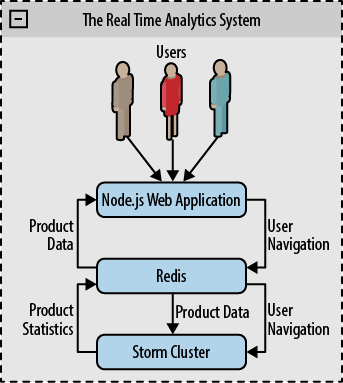Chapter 6. A Real-Life Example
The idea of this chapter is to illustrate a typical web analytics solution, a problem that is often solved using a Hadoop batch job. Unlike a Hadoop implementation, a Storm-based solution will show results that are refreshed in real time.
Our example has three main components (see Figure 6-1):
A Node.js web application, to test the system
A Redis server, to persist the data
A Storm topology, for real-time distributed data processing

Figure 6-1. Architecture overview
Tip
If you want to go through this chapter while playing with the example, you should first read Appendix C.
The Node.js Web Application
We have mocked up a simple e-commerce website with three pages: a home page, a product page, and a product statistics page. This application is implemented using the Express Framework and Socket.io Framework to push updates to the browser. The idea of the application is to let you play with the cluster and see the results, but it’s not the focus of this book, so we won’t go into any more detail than a description of the pages it has.
- The Home Page
This page provides links to all the products available on the platform to ease navigation between them. It lists all the items and reads them from the Redis Server. The URL for this page is http://localhost:3000/. (See Figure 6-2.)
Figure 6-2. Home page
- The Product Page
The Product Page shows information related to a specific ...
Get Getting Started with Storm now with the O’Reilly learning platform.
O’Reilly members experience books, live events, courses curated by job role, and more from O’Reilly and nearly 200 top publishers.

